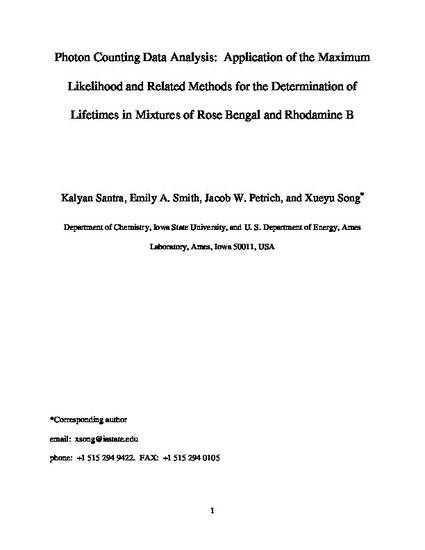
It is often convenient to know the minimum amount of data needed to obtain a result of desired accuracy and precision. It is a necessity in the case of subdiffraction-limited microscopies, such as stimulated emission depletion (STED) microscopy, owing to the limited sample volumes and the extreme sensitivity of the samples to photobleaching and photodamage. We present a detailed comparison of probability-based techniques (the maximum likelihood method and methods based on the binomial and the Poisson distributions) with residual minimization-based techniques for retrieving the fluorescence decay parameters for various two-fluorophore mixtures, as a function of the total number of photon counts, in time-correlated, single-photon counting experiments. The probability-based techniques proved to be the most robust (insensitive to initial values) in retrieving the target parameters and, in fact, performed equivalently to 2–3 significant figures. This is to be expected, as we demonstrate that the three methods are fundamentally related. Furthermore, methods based on the Poisson and binomial distributions have the desirable feature of providing a bin-by-bin analysis of a single fluorescence decay trace, which thus permits statistics to be acquired using only the one trace not only for the mean and median values of the fluorescence decay parameters but also for the associated standard deviations. These probability-based methods lend themselves well to the analysis of the sparse data sets that are encountered in subdiffraction-limited microscopies.
Available at: http://works.bepress.com/emily-smith/34/

This document is the unedited Author’s version of a Submitted Work that was subsequently accepted for publication as Santra, Kalyan, Emily A. Smith, Jacob W. Petrich, and Xueyu Song. "Photon Counting Data Analysis: Application of the Maximum Likelihood and Related Methods for the Determination of Lifetimes in Mixtures of Rose Bengal and Rhodamine B." The Journal of Physical Chemistry A 121, no. 1 (2016): 122-132, copyright © American Chemical Society after peer review. To access the final edited and published work see doi: 10.1021/acs.jpca.6b10728. Posted with permission.